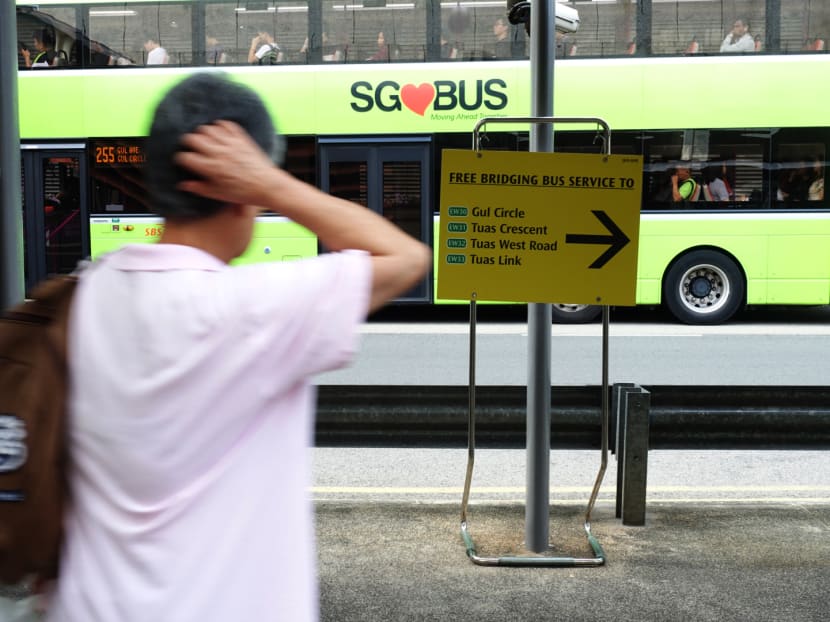Looking Ahead to 2018: Restoring public confidence in MRT vital for car-lite goal
SINGAPORE — Up until two confidence-sapping train incidents struck in consecutive months late in the year, various parts of the plan to convince the public that there would soon be little need to own a car in Singapore were coming together nicely.

A man looks at a sign directing him to free bus bridging services near Joo Koon MRT station, a day after the collision between two train stations at the station, on Nov 16, 2017. TODAY file photo
As the year draws to a close, TODAY kicks off a series looking at key issues on the local and foreign front in the next 12 months. In Singapore, we look at what lies ahead in areas ranging from political succession, climate change and the terrorism threat, to electronic payment, the property market and sports. Beyond our shores, the focus will be on the Malaysian general election and Singapore’s chairmanship of the Association of Southeast Asian Nations. In the fifth instalment of the series, we focus on issues surrounding public transport — the impact of the mishaps on the rail network and how the taxi industry will have to navigate the disruption from ride-hailing.
SINGAPORE — Up until two confidence-sapping train incidents struck in consecutive months late in the year, various parts of the plan to convince the public that there would soon be little need to own a car in Singapore were coming together nicely.
One thousand buses have been added to the roads under the billion-dollar Bus Service Enhancement Programme (BSEP), started five years ago to address the overcrowding situation. Service levels have also improved since the duopoly in the public bus industry was broken up with the introduction of the bus contracting model.
Car-sharing as an alternative was boosted by the entry of electric vehicle operator BlueSG, while bike-sharing became one more option for first- and last-mile connections.
The MRT network, however, was always seen as the centrepiece of Singapore’s car-lite vision, given that nearly every home will be within 10 minutes of a station, albeit years down the road.
With public confidence in the rail network shattered by the two high-profile incidents — an unprecedented tunnel flooding and a train collision — the authorities took swift action to set things right, curtailing operating hours on weekends to speed up maintenance and renewal works.
And how the MRT system holds up in 2018 — when a zero-growth policy for cars and motorcycles also kicks in — will have a big say in whether the drive to nudge more Singaporeans into relying on public transport for daily commuting gets back on track, experts said.
RESTORING TRUST IN RAIL
In the last few years, commuters have been told that extensive work on the existing lines is needed to improve reliability, but the process will inevitably involve some disruptions.
But commuters’ patience was tested when it unravelled that an unprecedented MRT tunnel flooding that downed service along a long stretch of the North-South Line over two days in October was caused by neglect by maintenance workers, who had carried out no work but covered up by faking records for nearly a year. Barely had the frustration subsided when two trains collided in the midst of preparations to transition the East-West Line to a new signalling system that promises shorter waiting times.
The decision was taken to cut operation hours and shut stations on weekends along parts of the East-West and North-South lines, aimed at getting the new signalling system up and running earlier, which will increase train frequency.
Urban transport expert Park Byung Joon from the Singapore University of Social Sciences (SUSS) said how the MRT system holds up in the first half of next year will be the litmus test for public confidence in daily commuting on public transport.
Public perception will be dealt another blow if major faults arise from the East-West Line’s re-signalling project, he said.
But “if the first six months of the year pass without much incident, then we’ll have a good year in terms of public transport”, added Dr Park.
Transport consultant Tham Chen Munn said physical improvements alone are not enough, though. Complaints have been growing louder that rail operators do not always alert commuters to delays, or do not accurately say how much longer travelling time will be, so “soft” strategies to regain commuters’ trust are just as important, he noted.
“How much of a time delay warrants an apology, like the Japanese? How would public communications help in allaying dissatisfaction?”
Keeping commuters updated beforehand on planned disruptions, which allow workers more time to do maintenance, will help them grasp the need for such work. “Only then can our commuters appreciate the reliability of Singapore’s MRT system. When this happens, rail transport becomes more attractive naturally,” said Mr Tham.
NEW RAIL LINES
Transport economist Walter Theseira, who also works at SUSS, said reliable train service, while important, would not be the decider in people’s decision on whether to give up their cars. Rather, the decision will hinge on better MRT network coverage, shorter travel times, and accessibility to MRT stations — all benefits that new lines being built will bring, though these will come on stream years down the road.
The Thomson-East Coast MRT Line will begin service in stages from 2019, while the Cross Island Line is due to be completed around 2030.
While acknowledging that other factors pull Singaporeans towards cars, such as the aspiration of car ownership among many for “status value”, Dr Theseira said it was too much to expect that the Government could change views on this front. What it can do is bridge the gaps in convenience.
“The gap is really in time savings, convenience and the ability to meet diverse needs. It’s not in reliability, although that is important,” he said.
Transport Minister Khaw Boon Wan had said commuters would see vast improvements in rail reliability by 2019. Right now, efforts to overhaul the North-South and East-West Lines, Singapore’s oldest and longest lines, are one-third complete.
Each of the lines’ core systems — including their signalling system, power supply and track circuits — must be replaced before reliability can be bumped up, the minister had said.
Aside from trains, the availability and reliability of other transport modes — from buses to shared bikes — also count in persuading the masses to give up their cars.
MORE FREQUENT BUSES
Amid measures to improve train reliability, which hastened after two massive rail disruptions in 2011, the Government announced in 2012 that bus service would be bolstered under a five-year effort to tackle congestion and long wait times. The BSEP wrapped up in December, with 1,000 Government-funded buses added to the roads, and 80 new bus services rolled out.
With the programme, bus service was now “adequate”, said Singapore Management University transport specialist Terence Fan.
The improved frequency, Dr Theseira said, helps cut travel time and raise reliability for commuters, which “will make the difference” in nudging more towards public transport.
The programme, along with the full transition to a bus contracting model last year, has resulted in bus capacity going up for about 70 per cent of bus services, less crowding during peak periods, and better punctuality, according to the Land Transport Authority (LTA).
Under the bus contracting model, operators earn a fee for running services while the Government retains fare revenues.
Though raising bus service quality and coverage will steer some towards public transport, Dr Theseira said he “would be very surprised if it accounted for more than a small number of switches”.
The bus and MRT networks complement each other, he noted.
“The main advantage of expanding the MRT network, as opposed to using more buses and transfers, is that having more direct MRT access would tend to, overall, result in a much smoother and faster journey,” he added.
MORE OPTIONS WITH SHARED BIKES, CYCLING NETWORKS
Besides feeder buses, dockless bicycle-sharing, which has taken off quickly in the past year, has given rise to one more commuting option between homes and transport centres.
Cycling connectivity is also set to grow further. By 2022, Tampines will triple its network of cycling paths and morph into a walking and cycling town — the second after Ang Mo Kio, the authorities announced earlier this year.
Last July, Ang Mo Kio residents began reaping the convenience of a 4km cycling path, the first stage of a 20km cycling network.
Residents who spoke to TODAY earlier this month noted that their journeys were more seamless.
Thrice a week, photographer Anton Tang, 33, cycles along the path to get to the AMK Hub shopping mall or the MRT station, but said he still uses his car for longer journeys.
While the path made for “faster and safer” commutes, freelance first-aid trainer Alan Lim said having more links between towns and to the Central Business District will encourage more people to switch.
The 39-year-old rides his e-scooter from Ang Mo Kio to towns as far-flung as Pasir Ris and Boon Lay, but has to ride on pavements and under expressways en route, owing to the lack of designated paths.
Dr Theseira was sceptical, however, that shared bicycles would make an effective difference to public-transport travel behaviour. At best, they are a substitute for neighbourhood-based public transport, he said.
“Whether they really solve the ‘first- and last-mile’ problem, which is that the start and end of journeys on public transport tend to be very time-consuming and inconvenient, remains to be seen,” he added.
*On Friday (Dec 29), look out for our report on Singapore’s efforts to mitigate the effects of climate change.
Missed the earlier reports from our Looking Ahead to 2018 series?








